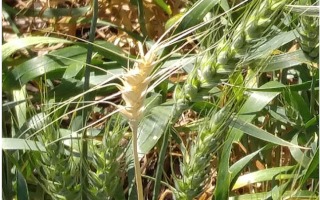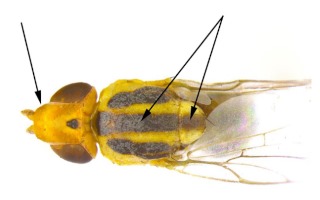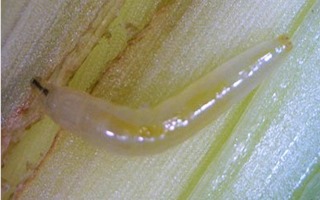By Adam Varenhorst
When scouting wheat, the presence of any bleached heads is easy to observe because of their stark contrast to the rest of the otherwise green field (Figure 1). The bleached heads are typically the result of feeding activity by wheat stem maggots, which can be confused with symptoms of Fusarium head blight (scab) infections.
The difference between wheat scab and wheat stem maggot symptoms is that plants infected by wheat scab will have partially bleached or completely bleached heads.

Adversely, plants infested by the wheat stem maggot will have entire heads that are bleached, and the upper internodes of the plant will also be bleached (Figure 1). Additionally, if the discolored head of a plant infested by wheat stem maggot is pulled on, it will easily pull out of the plant, and the base of the peduncle will have discoloration present due to feeding.
Identification
ADULTS

Wheat stem maggot adults are small, yellow flies (one-fifth of an inch long) with bright-green eyes. Adults have three black stripes present on their thorax, with the middle stripe longer than the other two (Figure 2). Magnification may be required for identification. Adults also have a segment on their heads that extends forward beyond their eyes. Adults of the wheat stem maggot are nectar feeders and lay eggs on the leaves and stems of wheat plants. When the eggs hatch, the larvae burrow into the stem and begin feeding near the flag leaf. This feeding prevents nutrient flow to the head. Although a wheat field may have many white heads due to wheat stem maggot feeding, it is still considered a minor pest, and chemical management is not recommended.
LARVAE

The wheat stem maggot larvae are small and vary from being nearly translucent to a white-green color (Figure 3).
The larvae are approximately one-quarter of an inch in length and are present inside of the wheat stem near the base of the head peduncle.
Lifecycle and Management
Wheat stem maggots have two generations per year in South Dakota. The first generation of wheat stem maggot flies emerge in early June and lay their eggs on the leaves of grasses, including wheat. The eggs hatch in mid-June to July, and the maggots will tunnel into the stems of the host plants. The wheat stem maggots feed for 1 to 2 weeks and then will pupate within the stems. The adults of the following generation will emerge in late July to August. The eggs laid by the second generation will either overwinter in grasses, or they may emerge and continue their lifecycles in the fall depending on weather conditions.
In 2023, wheat stem maggot infestations are currently considered minimal, and historically this is not a yield-limiting pest. There are no recommendations for insecticidal management of wheat stem maggots. This pest can be managed by rotating to a different crop and managing volunteer wheat and grass hosts within fields and around field margins.
Source : sdstate.edu